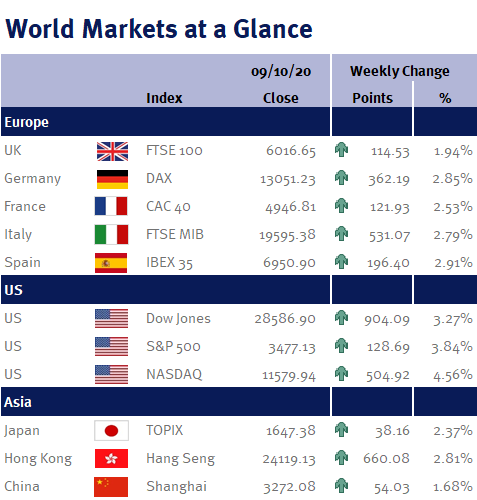Donald Trump dominated equity market sentiment this week.
Firstly, there was the extraordinary US Presidential debate debacle between Donald Trump and Joe Biden on Tuesday (29 September 2020) and then today (Friday 2 October 2020) news broke that Donald Trump tested positive for coronavirus.
As a consequence, we saw betting odds on Joe Biden’s US election victory increase and a classic equity market shoot from the hip, ‘sell first and ask questions later’ reaction, with share prices marked down today.
However, as you can see from the accompanying table, it wasn’t enough to stop the majority of equity markets from ending the week higher.
Although today’s news regarding Donald Trump means the outlook is a little more uncertain at the moment, it is important to keep an open mind about how things will evolve – and we believe that this could increase the pressure on the Republicans and Democrats to reach a deal on a new US fiscal stimulus plan, to help those Americans that have been hard-hit by the coronavirus outbreak and associated lockdowns (which will be positive for equity markets).
The need for this stimulus was underscored by a report released yesterday (Thursday 1 October 2020) which showed US personal income dropped sharply in August (-2.7%) thanks to the expiry of the extra $600 unemployment benefit payment. Given that a significant proportion of consumers in the US, like those in the UK, live from one payday to the next, it is only a matter of time before this fall in income is reflected in a slowdown in consumer spending and GDP data, as the US consumer accounts for two-thirds of the US economy.
Besides Donald Trump and coronavirus, our focus this week was on the US ISM Manufacturing data; weekly US jobless claims data; and September’s US non-farm payroll (employment) data – and the clear takeaway from all of these data releases was that the US economy continues to recover, but the recovery is starting to slow (i.e. the ‘V-shape’ recovery we have seen since the dark days in April, is starting to morph into a ‘Nike Swoosh’ – i.e. still a strong recovery, just slightly slower).
For example, the ISM reading for September came in at 55.4. 50 is the line separating expansion and contraction, so this reading shows that the US economy continues to expand. However, as the reading was lower than the August reading of 56.0, it suggests that the expansion is no longer accelerating.
While both the weekly initial and continuing jobless claims data declined (which is an improvement and therefore positive), the payroll data showed a rise of just 661,000 (reducing unemployment to 7.9% from 8.4%). This smaller than expected gain suggests to us that we are unlikely to see a continuation of the big employment gains we have seen since May, as without government support businesses are now starting to close – hence the ‘Nike Swoosh’ shaped recovery and the need for the Republicans and Democrats to reach a deal.
Elsewhere, headline Eurozone CPI inflation came in at -0.3%, while the core rate (which excludes volatile items such as food and energy) fell to 0.2%, a record low. Given the European Central Bank’s (ECB) target is for inflation to be close to 2%, these readings suggest to us that it is now when, not if, the ECB provides additional monetary stimulus.
Looking ahead to this coming week, besides the health of Donald Trump, we will be focusing on the minutes from the Fed’s last monetary policy meeting. Additionally, we have the weekly US jobless claims data; UK industrial and manufacturing production; UK GDP; Eurozone retail sales; and Chinese PMI data.
Additionally, we have the next Presidential debate between Vice President Mike Pence and Senator Kamala Harris on Wednesday (7 October 2020).
Investment Management Team


